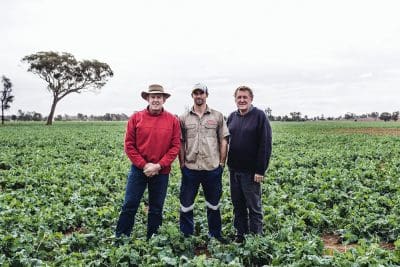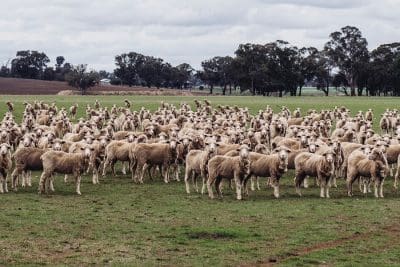A DESIRE to minimise the build-up of herbicide resistant weeds on their Junee property in southern NSW is a driving force behind the Curry family farming operation.

Glenn, Tim and Brian Curry review their weed management plan each winter and make any changes necessary to ensure weed numbers are kept low and the risk of herbicide resistance is minimised.
Brothers Glenn and Brian Curry use their livestock and cropping enterprises to great effect in their weed management plan.
Each winter they revisit their rotation plan with their agronomist, Greg Condon, and fill in the details according to the seasonal outlook and their assessment of the weed burden in each paddock.
“We have a farm plan for the coming five years or so that provides the general direction for the business, and weed management is a key component of that plan,” Glenn Curry said.
“The farm’s financial sustainability relies on effective weed management so we have firm strategies in place while remaining very flexible about how the strategies are implemented.
“When we sit down to make detailed plans for the next 12 to 18 months we look at what has worked well in the previous season and where we might have more weeds than expected.
“We are not afraid of making changes as the season unfolds either and having livestock in the system really gives us more options, like cutting a paddock for silage or turning it out to pasture earlier if we feel the weed pressure is getting ahead of us.”
The brothers have successfully farmed together all their adult lives and are now joined by Brian’s son, Tim.
Disciplined approach
Their weed management program is planned well in advance to ensure the most effective use of crop rotation and chemical group rotation to minimise the build-up of herbicide resistant weeds on the property.
A disciplined rotation is followed in their 12-metre controlled traffic farming (CTF), no till, stubble retention system, maintaining a high level of break crop area across the 2600 hectares of farmed land.
“Generally, we have one-third of the arable area under pasture and the rest is cropped,” Brian Curry said.
“We have used mainly canola as the break crop until recently when we have started to incorporate albus lupin in the rotation to gain more soil fertility benefits and aid in grass weed control. Break crops comprise about 40 to 45 per cent of the cropped area each year.”
Grain Central: Get our free daily cropping news straight to your inbox – Click here
The rotation commences with low grass weed numbers after the lucerne pasture is sprayed out and fallowed in spring.
TT canola is sown the following growing season then wheat, wheat, barley, albus lupin and back to lucerne/clover pasture for grazing.
The pasture is maintained for five or six years by which time it has become grassy and is returned to cropping.
This crop rotation allows the Currys to use a diverse herbicide program including atrazine, propyzamine and clethodim in TT canola, Sakura and trifluralin in wheat, Boxer Gold and Dual Gold in barley and finally, simazine, Factor, clethodim and paraquat in lupins.
In weedy paddocks, a double knock of glyphosate followed by paraquat is used prior to sowing.
Narrow windrow burning is used in canola to control any weed survivors.
Cereal crop areas that have higher ryegrass density are cut strategically as baled silage or ensiled in underground pits for use as stored fodder, killing the weed seeds in the silage process.
Livestock in the weed plan
The Currys moved out of cattle some years ago and now run 3800 Merino ewes comprised of 1600 ewes in a self-replacing merino wool production and breeding program and 2000 ewes producing cross-bred lambs.
They find sheep easier to manage than cattle and they are a good fit in their cropping program.

Dual purpose canola, stubble grazing, strategic silage making and a 5-year pasture phase are all part of the Curry family’s integrated weed management plan.
The sheep graze the crop stubbles and long growing season canola hybrids provide valuable feed in autumn and winter for the Merino wethers.
Dual purpose crops can be a weak link in the system where grass numbers can build up due to the early sowing dates, but these crops are needed to fill the winter feed gap and also provide the opportunity to use different herbicide groups to target grass weeds.
Crop paddocks that have become dirty with herbicide resistant annual ryegrass are sown out to lucerne and clover to reduce control costs and build soil fertility.
Crop competition and stubble management
In the medium to high rainfall environment of Junee, NSW, crop competition plays an important role in suppressing weeds.
The Currys use a flexicoil air seeder with tines and press wheels on 225mm (9 inch) spacing to sow their crops, usually into a high stubble load.
Brian Curry said they had to move out from 175mm (7 inch) row spacing to 225mm when they began full stubble retention a few years ago.
“Wheat crops here generally yield around 5t/ha and that is a challenging amount of stubble for tined planters to operate in,” he said.
“The slightly wider row spacing and the additional stubble cover seems to still provide acceptable suppression of weeds in the establishment phase, however we are looking at changing to a disc seeder in the future.”
Malting barley and spring wheat provide strong competition for weeds when sown at target plant populations that also optimise yield and quality.
Lancer and Beckom wheat varieties are preferred for their shorter stature and lower stubble volume.
Spray application
The Currys recently upgraded to a 36m Case Patriot boomspray to suit their CTF system.
The sprayer has the latest application technology including AIM Command, which enables section control of individual nozzles and improved drift management.
“Our farming system relies on effective herbicides and so we put a huge emphasis on spraying weeds when conditions are ideal so we can expect the best result possible every time,” Glenn Curry said.
For more information about managing herbicide resistance visit the Weedsmart website: www.weedsmart.org.au
Source: Weedsmart



HAVE YOUR SAY